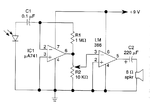rajaram04
Advanced Member level 3

Hello sir,
I want to make a wireless audio transmission circuit , Not with very much components but need a simple n easy one to get the motive
I have my audio signals ready to fed-in so need no audio transformer or something like that
Already i ve seen some headphone circuits its getting to expensive n too complicated.I don't want that i need simplest one . . please help
thanks
I want to make a wireless audio transmission circuit , Not with very much components but need a simple n easy one to get the motive
I have my audio signals ready to fed-in so need no audio transformer or something like that
Already i ve seen some headphone circuits its getting to expensive n too complicated.I don't want that i need simplest one . . please help
thanks




